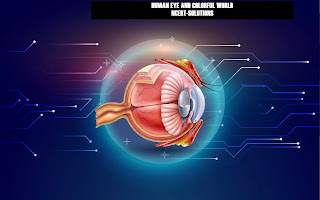Here I have provided you NCERT Solutions for Class 10 Science Chapter 11 Human Eye and Colorful World. I hope that this will certainly help you in your studies and examinations!
Page No 190
Q.1 What is meant by power of accommodation of the eye ?
Sol. The power of the eye by which it can see nearby objects as well as faraway objects by changing its focal length is called its power of accommodation.
Q.2 A person with a myopic eye cannot see objects beyond 1.2 m distinctly. What should be the type of the corrective lens used to restore proper vision ?
Sol. Concave lens
Q.3 What is the far point and near point of the human eye with normal vision ?
Sol.
Far point – Infinity
Near Point – 25 cm.
Q.4 A student has difficulty reading the blackboard while sitting in the last row.
What could be the defect the child is suffering from ? How can it be corrected ?
Sol. Myopia, concave lens
Exercise
Q.1 The human eye can focus objects at different distances by adjusting the focal length of the eye lens. This is due to
(a) presbyopia (b) accommodation
(c) near – sightedness (d) far – sightedness
Sol.
(b) Accommodation
Q.2 The human eye forms the image of an object at its
(a) cornea (b) iris
(c) pupil (d) retina
Sol.
(d) retina
Q.3 The least distance of distinct vision for a young adult with normal vision is about
(a) 25 m. (b) 2.5 cm.
(c) 25 cm. (d) 2.5 m.
Sol.
25cm.
Q.4 The change in focal length of an eye lens is caused by the action of the
(a) pupil (b) retina
(c) ciliary muscles (d) iris
Sol.
(c) ciliary muscles
Q.5 A person needs a lens of power – 5.5 dioptres for correcting his distant vision.For correcting his near vision he needs a lens of power + 1.5 dioptre.What is the focal length of the lens required for correcting (i) distant vision, and (ii) near vision ?
Sol.
(i) f=1P=−15.5=−0.1818m.
or
f=−18.18cm.
(ii) f=1P=11.5=0.666m.
f = 66.6cm.
Q.6 The far point of a myopic person is 80cm in front of the eye. What is the nature and power of the lens required to correct the problem ?
Sol.
Concave lens P=1f=−10080=−1.25D
Q.7 Make a diagram to show how hypermetropia is corrected. The near point of a hypermetropic eye is 1 m. What is the power of the lens required to correct this defect ? Assume that the near point of the normal eye is 25 cm.
Sol.
u = –25cm.
v = –100 cm.
1f=1v=1u
=−1100+125=3100
f=1003cm=13m.
P = –3D
Convex lens of power +3D is needed
Q.8 Why is a normal eye not able to see clearly the objects placed closer than 25 cm ?
Sol.
To see on object placed at a distance of less than 25cm, the ciliary muscles have to make the focal length still smaller, which puts strain on the ciliary muscles and they cannot make the focal length so small. Hence it is not possible to see at distance lens then 25 cm.
Q.9 What happens to the image distance in the eye when we increase the distance of an object from the eye ?
Sol.
Image distance does not change.
Q.10 Why do stars twinkle ?
Sol.
Due to atmospheric refraction, starlight bends from its path. Due to continuously changing atmosphere, starlight varies causing it to twinkle.
Q.11 Explain why the planets do not twinkle.
Sol.
Planets are much closer to the earth and can be considered as a collection of large number of point sources of light. If some light from plant is refracted, the effect is not observable and hence planets do not twinkle.
Q.12 Why does the Sun appear reddish early in the morning ?
Sol.
At sunrise, the sunlight has to pass through a thicker layer of atmosphere. Blue wavelength is scattered the most, hence blue is scattered away, leaving mainly red colour which reaches our eyes. Hence sky appears reddish.
Q.13 Why does the sky appear dark instead of blue to an astronaut ?
Sol.
Outside the earth, there is no atmosphere to scatter sunlight, so the sky appears dark or black to an astronaut in outer space.
Tags
Class 10


